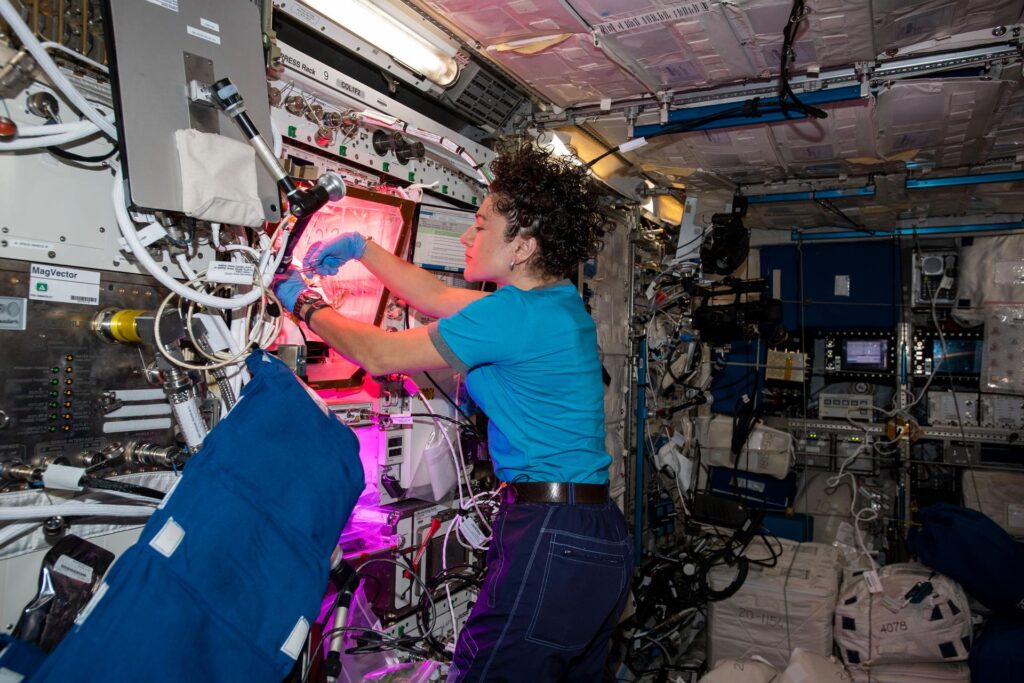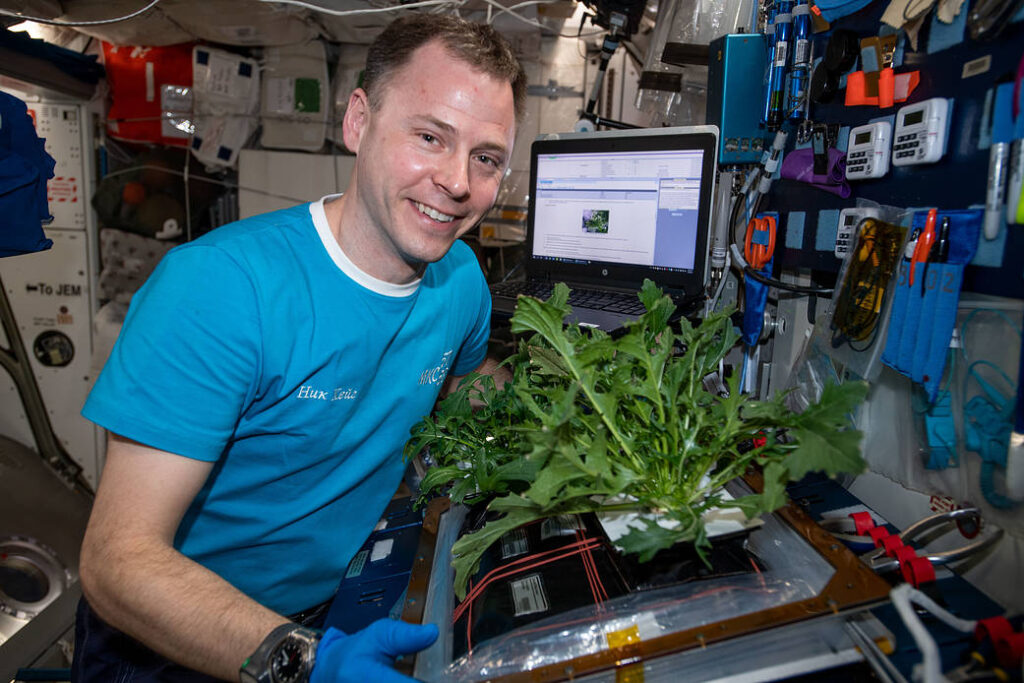Microgreens in Space

Why are edible plants important to space missions?
Future long-term space missions are critically dependent on sustainably maintaining both the physiological and psychological health of crew members. One important aspect is the ability to provide crews with optimal nutrition while reducing the need for Earth-based resupply. The cost and space requirements currently associated with food packaging, storage, and restocking are limiting factors to an extended human presence in space.
Cultivating produce in space may help mitigate health issues associated with long term space habitation such as; bone and weight loss, changes in blood cell production, radiation-induced cellular damage, impairment of eye function, and changes in the central nervous system. (Kyriacou, 2017) These health effects have been linked to emotional volatility, psychological stress and depression among space crews in the past. A 2006 study publication in the International Journal of Radiation Oncology outlined that antioxidants associated with targeted whole food consumption of crops, rather than intake through dietary supplementation, helped in mitigating many of the adverse effects of radiation-induced cellular oxidative stress. (Wan et al., 2006) In addition, the cultivation of plants on the ISS has shown to mitigate psychological stresses and depression associated with long-duration space habitation.
How are Space Crops Selected?
The ability to grow ready-to-eat plants in space not only provides dietary variety and nutrition; it may also serve as a way to keep crews both physically and mentally healthy while exploring new worlds. So how are plants selected to grow in space?
Ideal plants to be grown in space are selected based on the following criteria:
- crop potential (yield, edible biomass as well as oxygen production and water cycling)
- ratio of edible biomass to total biomass (also known as harvest index)
- crop growth efficiency (growth time and space required, nutritional value)
- crop horticultural needs (developmental monitoring, energy requirements, water consumption, harvesting, crew time requirements, and postharvest processing).
Plants grown in space should require minimal crew attention and preparation time, while producing nutrient-dense yields. Additionally, these plants need to have fast growth cycles while requiring minimal growth space and water intake.
An ideal crop type that fits this criteria are salad crops. Salad crops are suitable for modular chambers due to their low space requirements and high yields. Most salad crops have short growth cycles and require minimal care. In addition, many salad crops can be eaten fresh, so astronauts can get a bite to eat without needing to cook their food. We’ve grown many salad crops in space, but we’re always testing out new options to find better, more efficient crops. One of these exciting new salad crops is microgreens!

What are Microgreens?
Microgreens are small (2.5cm-8cm in height), colorful, nutrient-dense crops that are often used to enhance flavor in dishes. They vary in taste, which can range between neutral, bitter, and spicy.
Microgreens are considered “immature” plants, somewhere between baby greens and sprouts. However, they should not be confused for sprouts, since sprouts do not have leaves, but microgreens do. Grown from vegetable, legume, grass and herb seeds, microgreens typically have short species-specific production cycles lasting between one to three weeks. Microgreens are the same as normal vegetable plants, only they are harvested at a very young age, right after they grow their first true leaves.
Microgreen Nutrition
Though small, microgreens are very nutrient dense, and many microgreens contain compounds such as lutein, zinc, iron, potassium, and beta-carotene, and vitamins C, E, and K. Studies from the USDA have shown that at equal weights, microgreens contain 5 to 30 times more nutrients than what is found in the mature leaves of the same plants. Microgreens have also been shown to have antioxidant concentrations 40 times higher than their mature counterparts. (Xiao et al., 2012) The antioxidants found in microgreens have been shown to mitigate disease associated free-radicals and help in the production of compounds necessary for bone and tissue repair. (Domazetovic, Vladana et al., 2017)
Microgreen Highlight: Mizuna Mustard Greens
A microgreen that has been studied aboard the ISS due to its nutritional benefits as well its ability to thrive in the space environment is mizuna. Mizuna is a very popular microgreen used in Japanese cuisine that is high in several nutrients such as vitamins C and K as well as various antioxidants. This versatile leafy microgreen belongs to the mustard family and can be cultivated year-round. Mizuna is a popular hydroponic crop due to its relatively low amount of horticultural attention as well as its fast growth cycle.

(Image: © NASA)
As recent as 2019, Astronauts Jessica Meir and Christina Koch conducted a series of experiments aboard the international space station on mizuna grown in the Vegetable Production System (Veggie). The focus of these experiments was to collect valuable data regarding how light quality and fertilizers affect microbial safety, nutritional values, and crop flavor. This experiment was successful, and a portion of the leaves were eaten by the crew while the rest were frozen and sent back to Earth for further analysis.

(Image: © NASA)
The Benefits Of Microgreens in Space
Growing plants in space comes with an expanding array of challenges not encountered in traditional terrestrial agriculture. We could use microgreens to innovate space-focused plant cultivation systems, due to their specific requirements and growth cycles. One challenge associated with the spaceflight environment as it relates to plants are low levels of dissolved oxygen and nutrients in water used in hydroponic systems due to microgravity. Low levels of dissolved oxygen in water used in hydroponic systems can be fatal to plants, but luckily we can grow microgreens in shallow hydroponic substrate layers where dissolved oxygen is less of a problem. Since microgreens rely on their seeds for much of their energy, they need little to no nutrient supplementation, making them easier to grow than many other crops.
Another challenge to growing food in space is energy consumption. We use electrical lighting to grow plants in space, to ensure optimal light intensity and quality. LED lighting in plant growth systems has dramatically reduced the amount of energy required to provide optimal lighting for the crops. Microgreens generally have low lighting requirements, making their overall power demands lower than many other crops. In addition, LED lights can provide customized light recipes which could help elevate antioxidant production in microgreens.
Microgreens can be grown in restrictive spaces and consumed reality after harvest; making them ideal for space crews. Due to their high nutrient concentrations, fast growth cycles, high water/space-use efficiency, and minimal horticultural requirements, microgreens could someday become an integral component of an extraterrestrial bioregenerative life support system.
References:
Domazetovic, Vladana et al. “Oxidative stress in bone remodeling: role of antioxidants.” Clinical cases in mineral and bone metabolism : the official journal of the Italian Society of Osteoporosis, Mineral Metabolism, and Skeletal Diseases vol. 14,2 (2017): 209-216. doi:10.11138/ccmbm/2017.14.1.209
Kyriacou, M.C.; De Pascale, S.; Kyratzis, A.; Rouphael, Y. Microgreens as a Component of Space Life Support Systems: A Cornucopia of Functional Food. Front. Plant Sci. 2017, 8, 1587.
Wan, X. S., Ware, J. H., Zhou, Z., Donahue, J. J., Guan, J., and Kennedy, A. R. (2006). Protection against radiation induced oxidative stress in cultured human epithelial cells by treatment with antioxidant agents. Int. J. Radiat. Oncol. Biol. Phys. 64, 1475–1481. doi: 10.1016/j.ijrobp.2005.11.024
Xiao Zhenlei, Gene E. Lester, Yaguang Luo, and Qin Wang, (2012).
Assessment of Vitamin and Carotenoid Concentrations of Emerging Food Products: Edible Microgreens. J. Agric. Food Chem. 2012, 60, 31, 7644–7651. https://doi.org/10.1021/jf300459b
